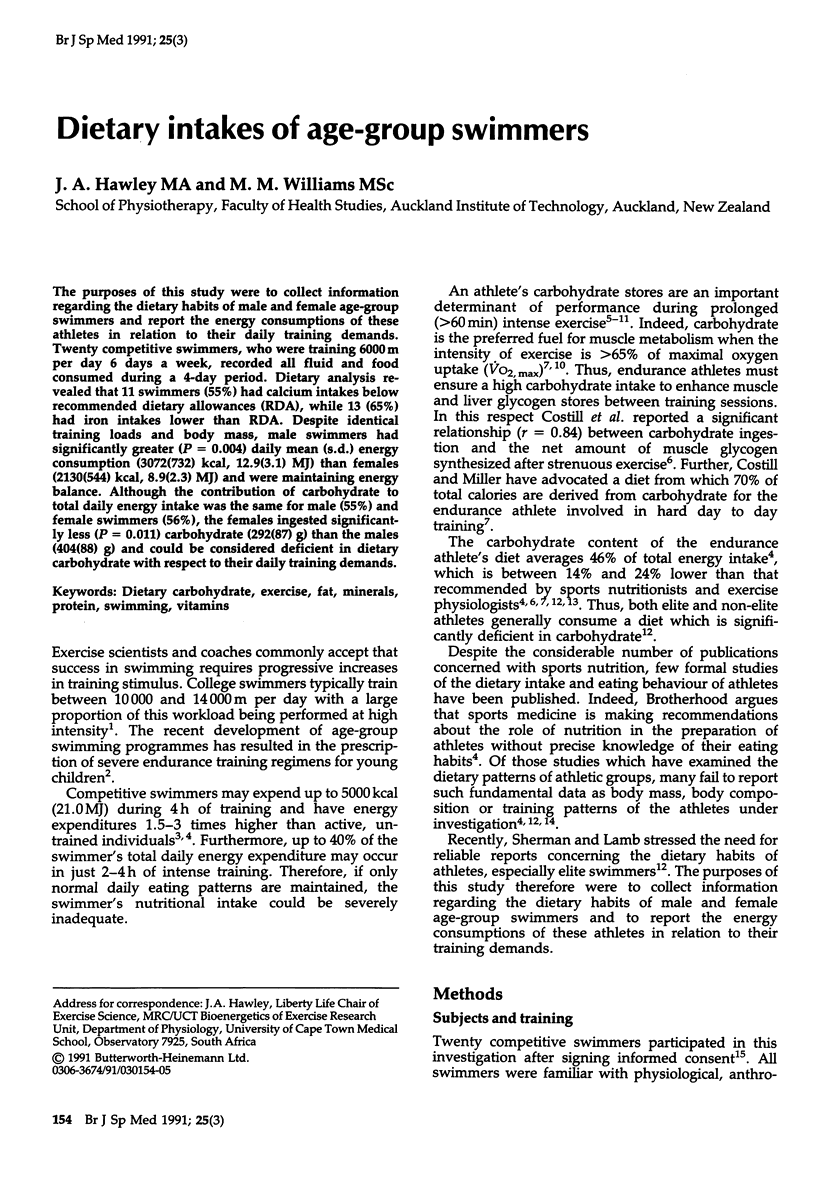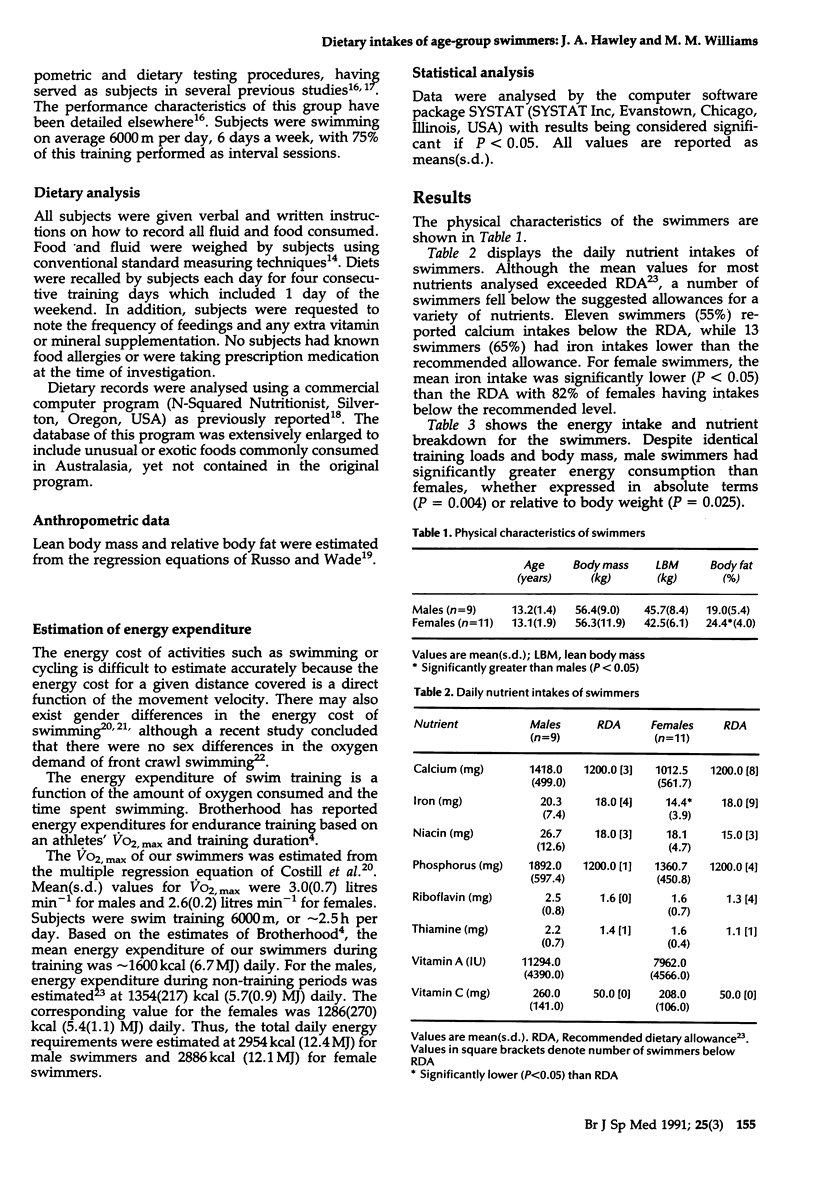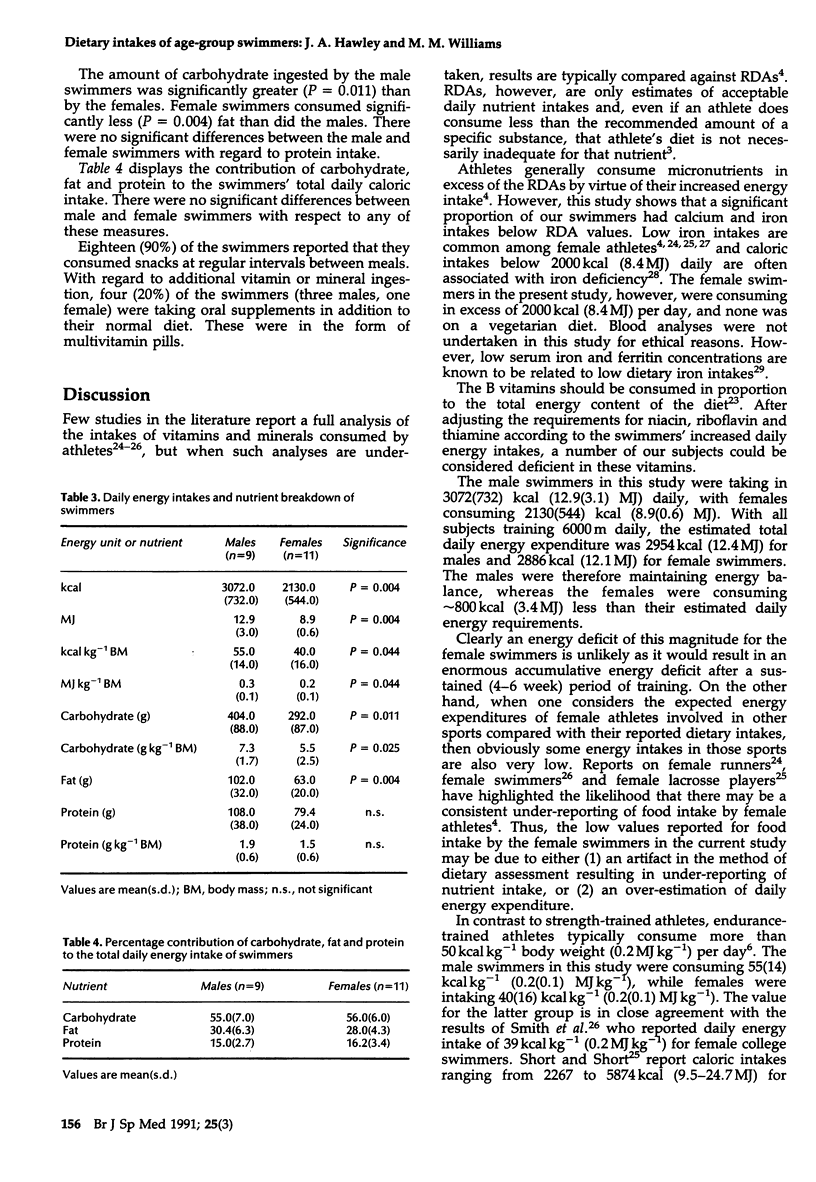Abstract
The purposes of this study were to collect information regarding the dietary habits of male and female age-group swimmers and report the energy consumptions of these athletes in relation to their daily training demands. Twenty competitive swimmers, who were training 6000 m per day 6 days a week, recorded all fluid and food consumed during a 4-day period. Dietary analysis revealed that 11 swimmers (55%) had calcium intakes below recommended dietary allowances (RDA), while 13 (65%) had iron intakes lower than RDA. Despite identical training loads and body mass, male swimmers had significantly greater (P = 0.004) daily mean (s.d.) energy consumption (3072(732) kcal, 12.9(3.1) MJ) than females (2130(544) kcal, 8.9(2.3) MJ) and were maintaining energy balance. Although the contribution of carbohydrate to total daily energy intake was the same for male (55%) and female swimmers (56%), the females ingested significantly less (P = 0.011) carbohydrate (292(87) g) than the males (404(88) g) and could be considered deficient in dietary carbohydrate with respect to their daily training demands.
Full text
PDF




Selected References
These references are in PubMed. This may not be the complete list of references from this article.
- Brotherhood J. R. Nutrition and sports performance. Sports Med. 1984 Sep-Oct;1(5):350–389. doi: 10.2165/00007256-198401050-00003. [DOI] [PubMed] [Google Scholar]
- Costill D. L., Fink W. J., Hargreaves M., King D. S., Thomas R., Fielding R. Metabolic characteristics of skeletal muscle during detraining from competitive swimming. Med Sci Sports Exerc. 1985 Jun;17(3):339–343. [PubMed] [Google Scholar]
- Costill D. L., Flynn M. G., Kirwan J. P., Houmard J. A., Mitchell J. B., Thomas R., Park S. H. Effects of repeated days of intensified training on muscle glycogen and swimming performance. Med Sci Sports Exerc. 1988 Jun;20(3):249–254. doi: 10.1249/00005768-198806000-00006. [DOI] [PubMed] [Google Scholar]
- Costill D. L., Kovaleski J., Porter D., Kirwan J., Fielding R., King D. Energy expenditure during front crawl swimming: predicting success in middle-distance events. Int J Sports Med. 1985 Oct;6(5):266–270. doi: 10.1055/s-2008-1025849. [DOI] [PubMed] [Google Scholar]
- Costill D. L., Sherman W. M., Fink W. J., Maresh C., Witten M., Miller J. M. The role of dietary carbohydrates in muscle glycogen resynthesis after strenuous running. Am J Clin Nutr. 1981 Sep;34(9):1831–1836. doi: 10.1093/ajcn/34.9.1831. [DOI] [PubMed] [Google Scholar]
- Dale E., Goldberg D. L. Implications of nutrition in athletes' menstrual cycle irregularities. Can J Appl Sport Sci. 1982 Jun;7(2):74–78. [PubMed] [Google Scholar]
- Durnin J. V., Ferro-Luzzi A. Conducting and reporting studies on human energy intake and output: suggested standards. Hum Nutr Appl Nutr. 1983 Apr;37(2):141–144. [PubMed] [Google Scholar]
- Grandjean A. C. Nutrition for swimmers. Clin Sports Med. 1986 Jan;5(1):65–76. [PubMed] [Google Scholar]
- Hawley J. A., Williams M. M. Relationship between upper body anaerobic power and freestyle swimming performance. Int J Sports Med. 1991 Feb;12(1):1–5. doi: 10.1055/s-2007-1024645. [DOI] [PubMed] [Google Scholar]
- Karlsson J., Saltin B. Diet, muscle glycogen, and endurance performance. J Appl Physiol. 1971 Aug;31(2):203–206. doi: 10.1152/jappl.1971.31.2.203. [DOI] [PubMed] [Google Scholar]
- Lemon P. W., Yarasheski K. E., Dolny D. G. The importance of protein for athletes. Sports Med. 1984 Nov-Dec;1(6):474–484. doi: 10.2165/00007256-198401060-00006. [DOI] [PubMed] [Google Scholar]
- Newhouse I. J., Clement D. B. Iron status in athletes. An update. Sports Med. 1988 Jun;5(6):337–352. doi: 10.2165/00007256-198805060-00001. [DOI] [PubMed] [Google Scholar]
- Pendergast D. R., Di Prampero P. E., Craig A. B., Jr, Wilson D. R., Rennie D. W. Quantitative analysis of the front crawl in men and women. J Appl Physiol Respir Environ Exerc Physiol. 1977 Sep;43(3):475–479. doi: 10.1152/jappl.1977.43.3.475. [DOI] [PubMed] [Google Scholar]
- Roberts K. M., Noble E. G., Hayden D. B., Taylor A. W. Simple and complex carbohydrate-rich diets and muscle glycogen content of marathon runners. Eur J Appl Physiol Occup Physiol. 1988;57(1):70–74. doi: 10.1007/BF00691241. [DOI] [PubMed] [Google Scholar]
- Short S. H., Short W. R. Four-year study of university athletes' dietary intake. J Am Diet Assoc. 1983 Jun;82(6):632–645. [PubMed] [Google Scholar]
- Smith M. P., Mendez J., Druckenmiller M., Kris-Etherton P. M. Exercise intensity, dietary intake, and high-density lipoprotein cholesterol in young female competitive swimmers. Am J Clin Nutr. 1982 Aug;36(2):251–255. doi: 10.1093/ajcn/36.2.251. [DOI] [PubMed] [Google Scholar]
- Vaccaro P., Clarke D. H., Morris A. F. Physiological characteristics of young well-trained swimmers. Eur J Appl Physiol Occup Physiol. 1980;44(1):61–66. doi: 10.1007/BF00421764. [DOI] [PubMed] [Google Scholar]
- Weight L. M., Noakes T. D., Labadarios D., Graves J., Jacobs P., Berman P. A. Vitamin and mineral status of trained athletes including the effects of supplementation. Am J Clin Nutr. 1988 Feb;47(2):186–191. doi: 10.1093/ajcn/47.2.186. [DOI] [PubMed] [Google Scholar]


